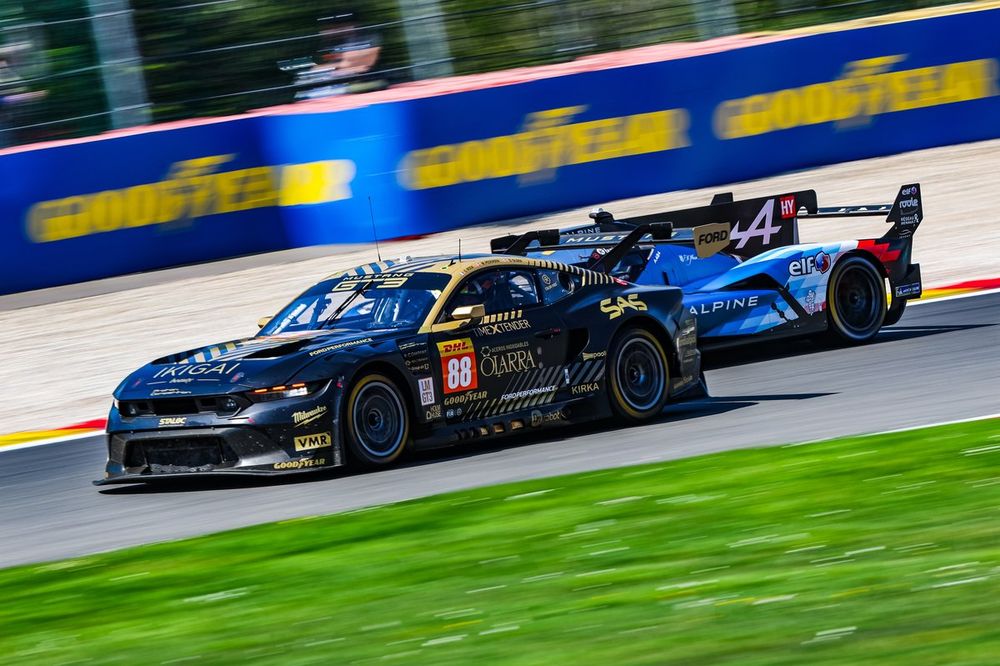Ryan Hardwick and Giorgio Roda, the bronze-graded drivers in the Proton Competition team that runs the Mustang in the WEC, both identified inexperience with the driveshaft-mounted sensors that enable power outputs to be regulated and help to uphold the Balance of Performance as the main element hampering Ford’s efforts.
Speaking to Motorsport.com, Hardwick said that the torque sensor is «the biggest thing holding us back when we’re around our competitors».
The 2023 European Le Mans Series GTE champion explained that while Proton continues to «make small improvements» with every race weekend, it remains «a long ways away» from the point of challenging at the sharp end in race trim.
«For us to compete at the top five or a podium, we have a long ways to go,» Hardwick said.
Several manufacturers have also experienced teething problems with the sensors, which are a new requirement for LMGT3 cars in 2024 but have been used in the Hypercar class since 2021. They work alongside the ECU to compensate for any spikes that exceed the maximum power allowed under the BoP and ensure cars are within the limits.
«The main thing is the experience from the torque sensor,» Roda told Motorsport.com. «It’s completely new for Ford. And every race is a new thing for us.
«Mechanically and set-up-wise we are getting there, every race we are getting closer. But the main issue is that torque sensor thing.»

#88 Proton Competition Ford Mustang LMGT3: Giorgio Roda, Mikkel Pedersen, Dennis Olsen
Photo by: Emanuele Clivati | AG Photo
In other series where the Multimatic-built Mustang GT3 races without torque sensors, including the IMSA SportsCar Championship and GT World Challenge Europe, it has proven competitive. Proton finished in the top 10 on the car’s GTWCE Endurance Cup debut at Paul Ricard, and has a best finish of fifth in the IMSA GTD class at Long Beach.
Torque sensors are also used in the LMGT3 class of the ELMS, although Ford currently has no presence in that series.
Hardwick noted that its WEC rivals «can just leave us out of the corners» and stressed that «it’s not because of the engine».
«The Ford makes plenty of power, we just aren’t good at putting the power to the ground in an appropriate way, which is this software and the coding with the torque sensor,» he said.
«Pretty much in every straightaway, our ECU is pulling power away from us where the others are getting power.
«It’s a bit frustrating right now. We’ll figure it out, but it’s just going to take time.»
Roda’s sixth place on the grid for Imola is the only occasion to date that the car has made Hyperpole in the WEC, but both cars made the points in the race for the first time at Spa.
Together with Mikkel Pedersen and Dennis Olsen, Roda’s car finished eighth, one place ahead of Hardwick, Zacharie Robichon and Ben Barker.

#88 Proton Competition Ford Mustang LMGT3: Giorgio Roda, Mikkel Pedersen, Dennis Olsen
Photo by: JEP / Motorsport Images
Proton will scale up to run a third Mustang at the Le Mans 24 Hours that factory driver Christopher Mies will share with ELMS regulars John Hartshone and Ben Tuck, as well as fielding an LMP2 entry and its regular Porsche 963 LMDh in Hypercar.
Roda is optimistic that at Le Mans the extra testing opportunities available will help Proton to get closer to the performance envelope «so we will maybe be nearer the other ones».
«We are altogether working to sort it out as well with the Ford and Multimatic guys, so I believe we’re going to get there,» he added.
«I don’t know when but sometime we’re going to get there.»
The Italian’s view is shared by Kevin Groot, the global sportscar manager for Ford Performance.
He said: «Overall, we are pleased with the progress we are making with Proton Competition and Multimatic in what are still the very early days for the Mustang GT3 programme.
«Every time we go racing, we are learning more and more about the car, the team and the drivers, and this puts us in a decent place for Le Mans.
«We did have some technical challenges during FP1 at Spa which we worked on and improved.
«Our focus now is on preparing for Le Mans and continuing to improve both the car and also understand more about the torque control systems.
«There are gains to be made in all areas and not just in the torque control, and the team have a good line of sight on what it takes to push the Mustang GT3 programme forwards.»








